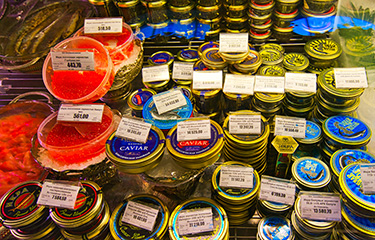The long-term consequences of a poor salmon season in Russia last year are starting to show as prices for salmon roe are rising.
The Russian Federal Agency for Statistics said prices for salmon roe began to rise in June 2020. In November 2020, the price exceeded RUB 4,000 (USD 54.25, EUR 46.10) per kilogram. In April 2021 prices reached a peak, the agency said, reaching RUB 4,700 (USD 63.75, EUR 54.39) per kilogram – up 30 percent compared to April 2020 and hitting a 10-year high.
Retailers cited increasing wholesale prices as the primary driver for higher shelf-prices. Rybset Business Development Director Polina Kyrova told Russian business journal RBC wholesalers had bumped up prices by 30 percent in April 2021 compared to April 2020, and Association of Production and Retail Fish Companies Vitaly Kornev said that price increase was as high as 50 percent.
Industry experts initially believed the April price hike to be part of a normal seasonal pattern. But a price drop that typically takes place after the 1 June start of the Russian salmon season has not yet materialized. SeafoodSource found salmon roe prices are still at the record levels at Russian retail chains Okay and Prisma.
As prices continue to sit at record highs, the market has started to see strange disruptions. Media Agency RIA Novosti reported in early July salmon roe had disappeared from stores in Vladivostok, the capital of the Primorye region in the Russian Far East. At other places in the city where roe was still available, prices jumped to RUB 9,000 (USD 121.44, EUR 103) per kilogram.
The average price per kilogram at specialty seafood shops in Vladivostok was RUB 6,500 (USD 87.71, EUR 74.37) for sockeye roe, RUB 6,000 (USD 80.10, EUR 68.64) for coho roe, and RUB 7,500 (USD 101.20, EUR 85.81) for king salmon roe. Two years ago, prices were half those seen now, RIA Novosti reported.
A tight supply caused by a low salmon season in 2020 is the core reason for the record prices. Last year, fishermen caught 290,000 metric tons (MT) of salmon – significantly lower than forecast. The poor forecast resulted in a push for scientists to rethink their predictive models to avoid future surprises.
The low harvest led to reduced production volumes of salmon roe. According to the Russian Federal Agency for Fisheries, only 11,000 MT of salmon roe was produced in 2020, versus 21,600 MT in 2019. The tight supply hit the retail sector just a few months after the season, in December, when consumption typically hits its peak.
Kyrova and Kornev both told RBC there was a very low inventory of high-quality roe, putting retailers in a bind.
A representative of the Russian Federal Agency for Fisheries told media salmon roe prices are likely to begin to decline by the end of August – as they normally do at the end of the salmon season, when fresh supply hits the market. The agency forecasts a total of 18,000 to 20,000 MT of salmon roe to be produced in Russia in 2021 – enough to cover the country’s annual consumption of 12,000 to 16,000 MT.
The agency’s position is shared Alexey Chekunov, the head of the Ministry for the Development of the Russian Far East and Arctic, who said the deficit of salmon roe in Vladivostok will disappear in the autumn after supplies of the product rise.
But domestic retailers are not yet sharing the government's optimism. Kornev said Russia's record salmon catches are unlikely to continue, and that he expects an average catch of around 300,000 to 350,000 MT over the next five years, which he said would result in salmon roe prices to continue increasing.
“We will see the levels of up to RUB 6,000 [USD 80.10, EUR 68.64] per kilogram,” he said.
Despite higher prices, Russian consumption of salmon roe is likely to experience only minor impacts. With salmon roe, falling prices tend to lead to greater consumption, but rising prices have almost no effect, Kornev said.
Following the record-breaking 2018 salmon season – when the harvest reached 676,000 MT, the best result in decades – salmon roe production nearly doubled, according to the Russian Federal Agency for Fisheries. The increased production caused prices to drop.
Market research company GfK said, based on a survey of 20,000 Russian households, that from October 2018 to September 2019 salmon roe consumption in Russia rose by 22 percent compared to the previous 12 months – coinciding with price decreases related to increased supply. Declines in prices started soon after the successful season, in December 2018, and continued into 2019, with June seeing prices of just RUB 3,594 (USD 48.49, EUR 41.11) per kilogram, down 10 percent year-on-year.
But the law of supply and demand isn’t as straightforward for salmon roe.
“Salmon roe is mostly consumed by households on special occasions, including birthday celebrations, New Year’s festivities, and Maslenitsa, a traditional Slavic festivity when people cook and eat a lot of pancakes. It’s a rather expensive product and it’s consumed little,” Eldar Kabirov, the co-owner of the Pizza 22 restaurant chain and St. Petersburg high-end restaurant Red Steak and Wine, told SeafoodSource. “At restaurants, salmon roe is used as an ingredient for various dishes, but it’s again not big volumes. The growth of prices will not affect the consumption much, given the peculiarity of the product and its use connected to national traditions.”
According to statistics, salmon roe consumption in Russia is around 100 grams per capita, an amount that’s affordable for most consumers, even at the current record price levels.
Photo courtesy of twabian/Shutterstock







